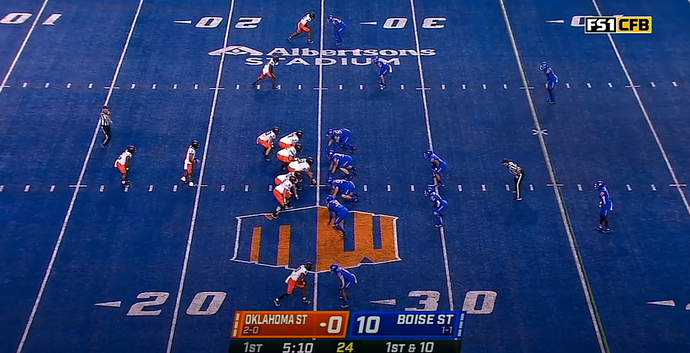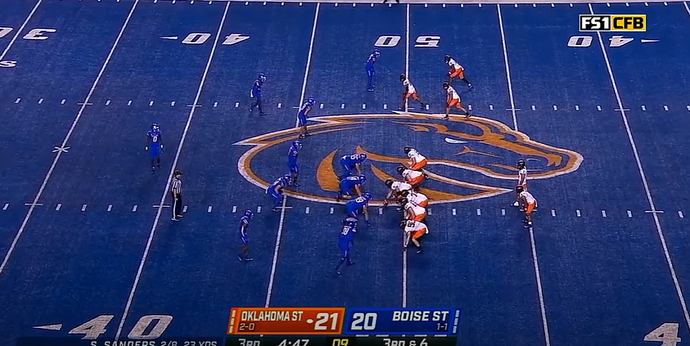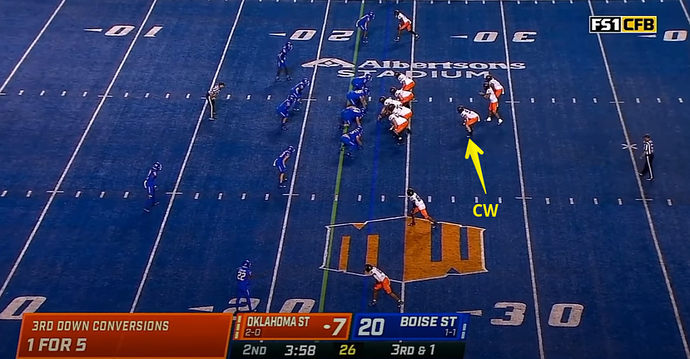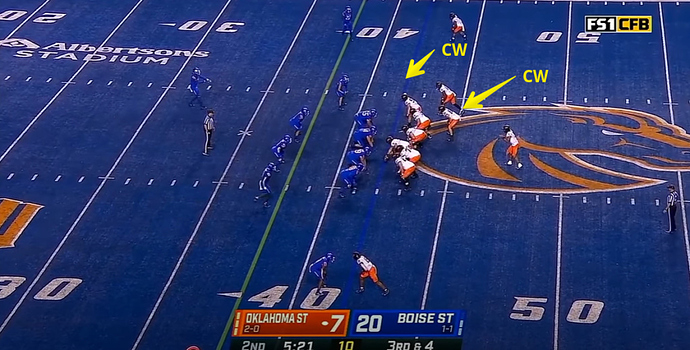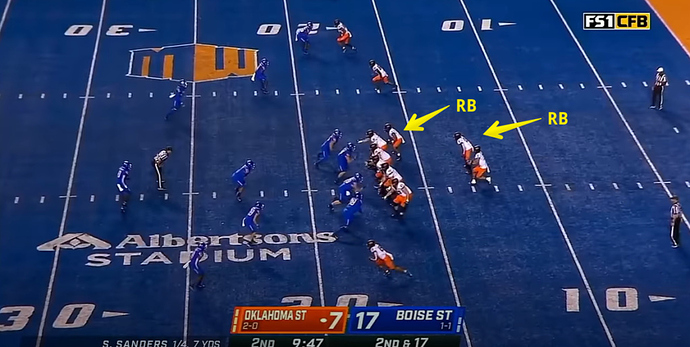Oklahoma State recorded its third victory of the 2021 season this past weekend against Boise State, 21-20. The Cowboys got behind 20-7 in the first half, but with a 218-yard rushing performance from Cowboy running back Jaylen Warren and some stellar play from the OSU defense in the second half, the Pokes were able to leave Boise with a win.
The Cowboys again were plagued with injuries and were very thin at wide receiver, including missing starters Braydon Johnson and Tay Martin for the second straight week. Young wideout Jaden Bray also missed this one and Bryson Green left the game early with a hand injury.
For Part 1 of this week's two-part offensive film study, I'll take a look at the overall scheme and what the Pokes were trying to accomplish against the Boise State defense on Saturday.
Personnel Groupings
Without much depth or experience at the wide receiver position, I was expecting to see some different formations and personnel groupings from Oklahoma State offensive coordinator Kasey Dunn against BSU. And, in the first half of this game, we saw just that as the Pokes went with their 20-personnel sets, or two running back, more often than we've seen this season (29% of their first half plays). In fact, the Cowboys completely went away from 20 personnel in their matchup with Tulsa. However, in the second half the Cowboys relied heavily on their 11 personnel, or one Cowboy back, formations.
Now let's take a look at the full game breakdown below. I'm counting 67 total plays, as opposed to 70, as I'm excluding the three kneels to end the game.
- 10 personnel: 7%
- 11 personnel: 54%
- 12 personnel: 21%
- 13 personnel: 3%
- 20 personnel: 15%
With the increased usage of 11 and 20 personnel, OSU also saw its lowest usage percentage of 10 personnel this season, or four wide receiver formations. This was most likely due to the lack of depth at WR caused by injuries.
Now, let's take a look at the run/pass splits out of each grouping. For this set of statistics, I'm counting both sacks as passing plays.
10 personnel
- Pass - 2 plays (40%)
- Run - 3 plays (60%)
11 personnel
- Pass - 7 plays (19%)
- Run - 29 plays (81%)
12 personnel
- Pass - 2 plays (14%)
- Run - 12 plays (86%)
13 personnel
- Pass - 0 (0%)
- Run - 2 plays (100%)
20 personnel
- Pass - 4 plays (40%)
- Run - 6 plays (60%)
Lastly, let's look at the breakout by yards gained. For this set of statistics, the two sacks are being counted as running plays.
- 10 personnel: 5 yards (1.0 yards per play)
- 11 personnel: 253 yards (7.0 yards per play)
- 12 personnel: 73 yards (5.2 yards per play)
- 13 personnel: 5 yards (2.5 yards per play)
- 20 personnel: 11 yards (1.1 yards per play)
Overall Scheme
The Broncos base out of a 3-3-5 looks with their EDGE defender normally playing on the line of scrimmage, which looks more like a four down linemen front. However, they will mix things up quite a bit to try and confuse their opponent. In coverage, it looked like they were mostly in Quarters, with some man, Cover 3 and Cover 6 mixed in, though with how few passing attempts OSU had, there wasn't really much film on their coverage looks. BSU brought some pressure, and the Bronco defense threw a lot of stunts at the Cowboy offensive line which found some success.
From OSU's standpoint, it was pretty obvious after Warren broke the long run that Dunn saw something in the Boise State defensive scheme that he could exploit, and he went to the ground game heavily. At one point, the Cowboys ran the ball 21 plays in a row. The Pokes focused on controlling the clock and dominating the Broncos on the ground, and it ended up working out for them. If you remove the three kneels and the two sacks from the rushing stats, Oklahoma State averaged 5.2 yards per rushing attempt.
As mentioned above, the Cowboys primarily based out of 11 personnel. Their go-to formation from this game featured the one Cowboy back in an H-Back position, with two receivers, or Twins, to one side of the formation and single receiver to the other, as shown below.
However, we also saw a “nub” tight end (Cowboy back) formation, shown in the following image.
And, the CW lined up in the backfield in a fullback position.
In the running game out of 11p, the Cowboys mainly stuck to their Inside, Outside and Split Zone, but they also mixed in QB Draw, QB Sneaks and a reverse. Through the air, there were a couple of play action attempts, a zone beating completion to Rashod Owens and an run-pass option (RPO) mixed in. We'll get into all of this more in Part 2, but the real thing that stuck out to me for this post was the amount of motion that was used, especially in the first half.
The Pokes had motion on nearly every play during the first two quarters, and lot of motion we haven't seen yet this year, like the Orbit motion shown below.
In addition, the return motion shown in the next clip.
Out of 12 personnel, OSU went to the Diamond formation on several occasions, but they also showed some new looks that we hadn’t seen yet this season, such as the one below.
As you can see above, OSU one Cowboy back in the H-back spot, and the other Cowboy back split out next to the right tackle. The Pokes also have a receiver in tight next to this Cowboy back. I'll touch on this play in more detail in Part 2.
Out of 12 personnel, OSU mainly stuck to the ground game as it only ran two true passing plays out of this formation. It was mainly zone, with some QB designed zone runs sprinkled in, and a couple of Power rushes.
In their two running back, 20 personnel sets, Dunn threw multiple interesting formations on the field against BSU. First, they had Warren split wide in a 2x2 receiver look, and then they motioned him back into the backfield and motioned LD Brown out wide. See below.
The Pokes also went with this Trips, or three receiver, formation into the boundary, with Brown split as the outside receiver. Then, just before the snap they motioned him back into the backfield.
Dunn also lined one of the running backs up in the H-back position, which is typically handled by the Cowboy back. This is one I don’t think I’ve seen before since he was named offensive coordinator.
In 10 personnel, OSU typically went with a Trips look with pre-snap motion from wide receiver Brennan Presley, and out of 13p, it was primarily their I-formation set.
Conclusion
Overall, I thought this was Dunn's best game scheme-wise this season. It wasn't flashy, but the Cowboys used misdirection and motion to open things up in the running game and used some new formations and running concepts (especially in the first half) that we hadn't seen yet this year. In the Tulsa game, we saw the Pokes line up and run to the strong side on almost every single rushing attempt, however, that was not the case against the Broncos, as they mixed it up throughout the game. Additionally, I really liked the designed quarterback runs added into this game.
In regards to the running backs, it was pretty much all Warren, and I thought he ran really well. His ability to turn plays that should be stopped for no gain into three to four yard gains is pretty incredible. The fumble wasn't great, but other than that he played an amazing game.
The offensive line had a nice day run blocking, specifically right guard Hunter Woodard, left guard Josh Sills and center Danny Godlevske. Having Woodard back was huge for the rushing attack and will be going forward. In terms of pass blocking, as I mentioned at the beginning of this post, there were some issues on stunts and both right tackle Jake Springfield and left tackle Cole Birmingham struggled at times, but overall I didn't think it was a poor performance.
The receivers had a few drops, and they need to do a better job in the route running department to help them get open downfield. However, Owens had a couple of nice catches, and walk-on Cale Cabbiness made a big grab when it counted.
I thought overall Sanders played a solid game. He didn't force anything, and he took what the defense gave him. I still thought there were a few times where he should've kept the ball on the read plays, but he did well overall in the rushing department.
Next up, I'll go into further detail on the Cowboy rushing attack and touch on the passing game in Part 2.
